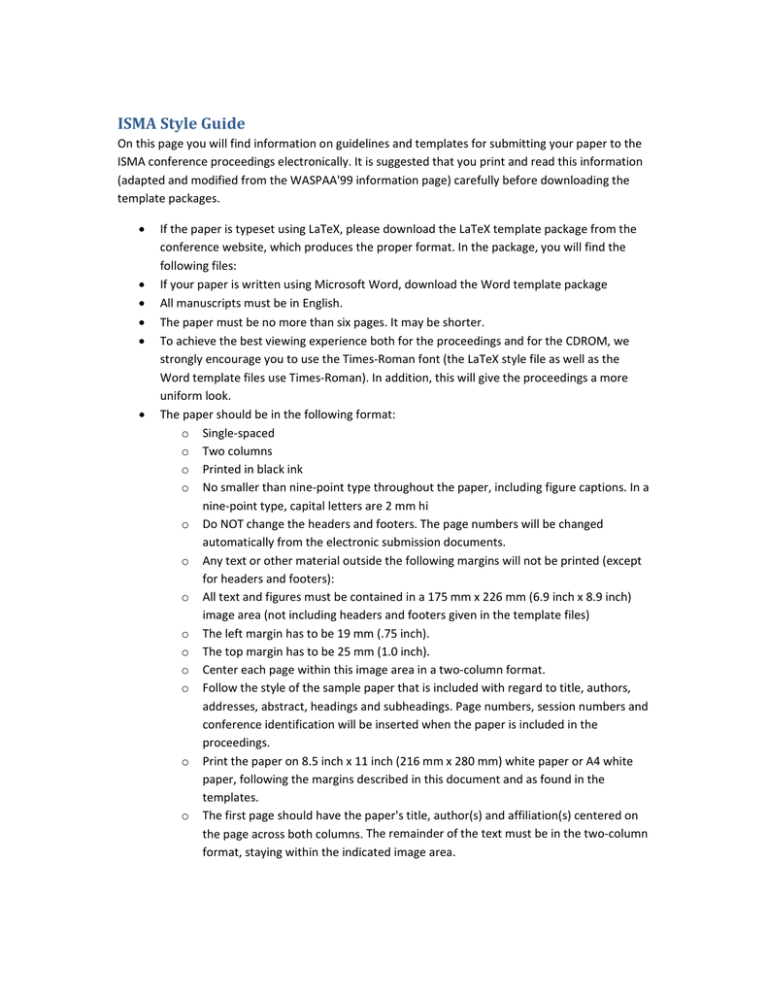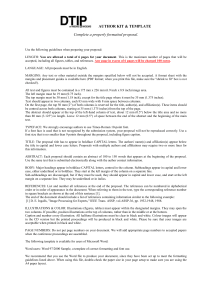ISMA Style Guide
advertisement

ISMAStyleGuide On this page you will find information on guidelines and templates for submitting your paper to the ISMA conference proceedings electronically. It is suggested that you print and read this information (adapted and modified from the WASPAA'99 information page) carefully before downloading the template packages. If the paper is typeset using LaTeX, please download the LaTeX template package from the conference website, which produces the proper format. In the package, you will find the following files: If your paper is written using Microsoft Word, download the Word template package All manuscripts must be in English. The paper must be no more than six pages. It may be shorter. To achieve the best viewing experience both for the proceedings and for the CDROM, we strongly encourage you to use the Times‐Roman font (the LaTeX style file as well as the Word template files use Times‐Roman). In addition, this will give the proceedings a more uniform look. The paper should be in the following format: o Single‐spaced o Two columns o Printed in black ink o No smaller than nine‐point type throughout the paper, including figure captions. In a nine‐point type, capital letters are 2 mm hi o Do NOT change the headers and footers. The page numbers will be changed automatically from the electronic submission documents. o Any text or other material outside the following margins will not be printed (except for headers and footers): o All text and figures must be contained in a 175 mm x 226 mm (6.9 inch x 8.9 inch) image area (not including headers and footers given in the template files) o The left margin has to be 19 mm (.75 inch). o The top margin has to be 25 mm (1.0 inch). o Center each page within this image area in a two‐column format. o Follow the style of the sample paper that is included with regard to title, authors, addresses, abstract, headings and subheadings. Page numbers, session numbers and conference identification will be inserted when the paper is included in the proceedings. o Print the paper on 8.5 inch x 11 inch (216 mm x 280 mm) white paper or A4 white paper, following the margins described in this document and as found in the templates. o The first page should have the paper's title, author(s) and affiliation(s) centered on the page across both columns. The remainder of the text must be in the two‐column format, staying within the indicated image area. AdditionalInstructions For 9‐point type, there should be no more than 3.2 lines/cm (eight lines/inch) vertically. This is a minimum spacing; 2.75 lines/cm (seven lines/inch) will make the paper much more readable. Larger type sizes require correspondingly larger vertical spacing. Paper Title: The paper title has to appear in capital letters, boldface if possible, centered across the top of the two columns on the first page as indicated above. Authors' Name(s): The authors' name(s) and affiliation(s) appear below the title in capital and lower case letters. If space permits include a mailing address here. The templates indicate the area where the title and author information should go. These items need not be strictly confined to the number of lines indicated; papers with multiple authors and affiliations, for example, may require two or more lines for this information. However, the placement of the title should be immediately below the top line. Abstract: Each paper should contain an abstract that appears at the beginning of the paper. Major Headings: Major headings appear in capital letters, bold face, centered in the column. Examples of the various levels of headings are included in the templates. Subheadings: Subheadings appear in capital and lowercase letters in boldface. They start at the left margin on a separate line. Sub‐Subheadings: Sub‐subheadings appear in capital and lowercase letters and are indented like a paragraph and on a separate line. They are in italics. References: List and number all references at the end of the paper. The references are numbered in order of appearance in the document. When referring to them in the text, type the corresponding reference number in square brackets as shown at the end of this sentence [1]. [1] D. E. Ingalls, "An Important Paper," IEEE Trans. ASSP, vol. ASSP‐36, pp. 1932‐1948, 1988. Illustrations: Illustrations must appear within the designated margins, and must be furnished positioned within the paper. They may span the two columns. If possible, position illustrations at the tops of columns, rather than in the middle or at the bottom. Caption and number every illustration. All half‐tone illustrations must be clear black and white prints. Line drawings may be made in black ink on white paper. Do not use any colors in illustrations. WWW URL links: Authors are encouraged include the WWW URL address in the paper and/or abstract to refer to any online information related to the paper, like accompanied audio/video files and links of relevant publications and demos. The URL link information allows authors to share proper and updated information with (re)viewers. Layout Specifications: Authors should submit files with up to four 216 mm wide x 280 mm high (8‐1/2" x 11") pages that will be printed exactly as received, without any reduction. A4‐ size paper also acceptable for submission; keep the top and left margins as specified. Detailed size specifications for the layout are given below. Text should appear in two columns, each 83 mm wide with 8 mm space between columns. On the first page, the top 50 mm (2") of both columns is reserved for the title, author(s) and affiliation(s). These items should be centered across both columns, starting at 25 mm (1") from the top of the paper, as shown in the examples. The abstract should appear at the top of the left‐hand column of text, about 12 mm (1/2") below the title area and no more than 80 mm (3‐1/8") in length. Leave 12 mm (1/2") space between the end of the abstract and the beginning of the main text. On the second and subsequent pages, the text or illustrations begin at the top of the page.

